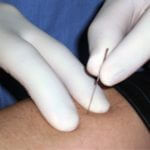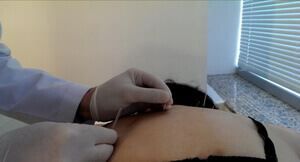What is Dry Needling?
 Dry Needling has been developed by Travel and Simmons, who were the first ones to diagnose and treat myofascial pain syndrome approximately 50 years ago. Myofascial pain syndrome manifests itself with intramuscular taut bands and trigger points inside of these bands. Although muscle is the biggest tissue of the body, muscle pain is generally neglected. Myofascial pain may develop secondary to conditions such as spinal and cervial disc herniation. Injections of Local Anesthetics or just needling these trigger points provide a high level of efficacy when combined with stretching exercises.
Dry Needling has been developed by Travel and Simmons, who were the first ones to diagnose and treat myofascial pain syndrome approximately 50 years ago. Myofascial pain syndrome manifests itself with intramuscular taut bands and trigger points inside of these bands. Although muscle is the biggest tissue of the body, muscle pain is generally neglected. Myofascial pain may develop secondary to conditions such as spinal and cervial disc herniation. Injections of Local Anesthetics or just needling these trigger points provide a high level of efficacy when combined with stretching exercises.
Watch Dry Needling Video
How To Perform Dry Needling
This method includes inserting very thin needles into the most sensitive points, i.e. trigger points, of the muscle. The needles must be as thin as acupuncture needles. This method differs from acupuncture with the insertion of the needle into the intramuscular trigger point rather than acupuncture point. The needle is held steadily for a while and then slowly rotated. After a couple of minutes, the needles take effect to relax the stretched muscle and then the needles are easily pulled out. It is also favorable to administer injection of local anesthetics with very thin needles instead of dry needling. Injection of local anesthetics is a less painful method but as dry needling method does not include any medication, it does not pose any risk of side effects. Also, in the cases the muscle pain is spread into a large area, it is not possible to inject local anesthetics into each point, making dry needling a more favorable method. If the muscles are softened via cold spraying and heat shock application before dry needling, it would provide even better results. This method can be applied for 3-5 times, or maybe more, at intervals of a couple of days depending on the patient’s condition.

Is It A Painful Method?
As dry needling includes very thin needles, this method is not quire a painful method. In the cases of severe muscle pain, this method can be applied upon relaxation of the muscle via physical therapy methods. For very sensitive cases, a superficial cream for anesthesia of the skin may be used.
The Disorders For Which Dry Needling Can be Used
It is often preferred in the treatment of primary myofascial pain syndrome, secondary muscle pain due to lumbar and cervical disc herniations, fibromyalgia, headache, muscle spasms in one’s back and neck. It is especially administered for painful disorders on the back and neck. It is also worth noting that dry needling method is not indicated for all types of musculoskeletal disorders. This method will not provide any efficacy in many disorders that are not related to muscle tissues such as inflammatory rheumatism, knee and hip osteoarthritis. Dry needling must be supported with complementary therapies. In this matter, dry needling method must be combined with stretching exercises specified for the relevant muscles. Dry needling provides high efficacy in appropriate cases. However, we should also bear in mind that it is not a revolutionary solution for every condition.

